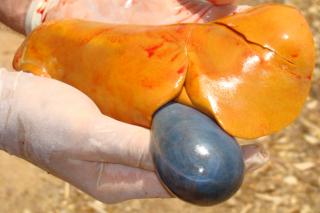Calling a vet to investigate diseases protects marketsThe WA Livestock Disease Outlook provides information about recent livestock disease cases in Western Australia and diseases likely to occur in the next month. Calling a vet to investigate diseases when they occur provides surveillance evidence to our markets that we are free of reportable and trade-sensitive diseases. |
Recent livestock disease cases in WA
Respiratory disease and deaths in calves in the far north
- In a mob of 150 calves, 7 were found dead and 15 affected with severe dyspnoea, laboured breathing and recumbency.
- The calves had been in yards for two weeks due to cyclonic weather. They were returned to pasture with clinical signs appearing a few days’ later.
- Of 4 calves necropsied, 3 had liver and lung abscesses.
- Laboratory testing showed pneumonia, hepatitis and pericarditis.
- The pneumonia was likely bacterial in origin with bacterial morphology consistent with Pasteurellacae. Fusobacterium was identified in the liver.
- The risk of bacterial pneumonia in calves may be increased during periods of close confinement and stress where the bacteria can be easily spread through aerosol and contact. The risk can be reduced by addressing stress factors where possible and ensuring good overall immunity.
- Key samples: Fresh lung and lung swab in gel transport medium.
- Reportable rule-outs: The exotic disease, haemorrhagic septicaemia (caused by certain serotypes of Pasteurella multocida), and the reportable disease, anthrax [1], were ruled out by the laboratory testing, helping to support WA’s proof of freedom from these diseases.
Lupinosis and nutritional myopathy cause deaths in Wheatbelt sheep
- More than 200 Merino wethers died on one property in January following summer rainfall.
- Sheep were grazing lupin stubble at the time and the initial 200 deaths were attributed to lupinosis.
- The sheep were immediately removed to oat stubble and were provided supplementary hay.
- Deaths in the flock began again a month later and further investigation was undertaken.
- Two sheep were submitted for postmortem: one with weakness, lethargy, recumbency and pallor; and one 4-year-old sheep with weakness and head pressing that later died.
- The first sheep had mild liver disease consistent with previous lupinosis [3]. Changes in skeletal muscle and severely depressed plasma vitamin E indicated nutritional myopathy. Nutritional myopathy is usually associated with vitamin E or selenium deficiency [4] but has also been associated with lupinosis.
- The second sheep had liver lesions consistent with chronic lupinosis due to previous exposure leading to hepatic encephalopathy.
- Key samples (include base sample set): Fresh and fixed liver and skeletal muscle, brain, blood, lupin samples.
- Reportable rule-outs: Given its age and the presence of neurological signs, the brain was submitted for testing for transmissible spongiform encephalopathies (TSE) [5]. The results ruled out TSE, which helps to support Australia’s proof of freedom from scrapie [6].
- A vitamin E drench for the flock would be advisable as would limiting unnecessary movement of the sheep to reduce the potential for further muscle damage and deaths from nutritional myopathy.
In autumn, watch for these livestock diseases:
| Disease, typical history and signs | Key samples |
|---|---|
Pink eye in cattle and sheep [7]
| Antemortem:
|
Polioencephalomalacia (PEM) in sheep and cattle [11]
| Antemortem:
Postmortem:
|
Note: Include base samples and any clinical or gross lesions in submissions. For sample submission advice, contact your DPIRD field vet [10] or the duty pathologist on +61 (0)8 9368 3351.
Neurologic signs in cattle? Remember Bucks for Brains!
We need your help to meet WA’s surveillance targets for bovine spongiform encephalopathy (BSE – mad cow disease) in cattle for the 2017/18 financial year. Australia does not have BSE but we need ongoing surveillance to maintain market access for our cattle and cattle products. If you see any cattle with gait abnormalities such as wobbling, staggers or goose-stepping, constant trembling or increased sensitivity to sound and touch, consider whether they may be suitable for postmortem under the TSE program.
Under the program, the cattle owner receives a subsidy of $300 per animal for up to two animals and veterinary, sample freight and laboratory costs are normally covered. The DPIRD NTSESP webpage [5] explains the program, conditions, criteria for eligibility and rebates or you can contact your local DPIRD vet [10].
See the latest in Emergency Animal Disease Alerts [13]
See the Department of Agriculture and Water Resources’ EAD Alerts newsletter [13] for updates on the exotic diseases African swine fever and bovine tuberculosis and the latest on Mycoplasma bovis in New Zealand.
Find out the latest in Department veterinary news
The latest issue of DPIRD’s Fit to trade bulletin [14] features articles on an antimicrobial resistance study [15] underway in WA cattle, a new disease model [16] that would be used to fight foot-and-mouth disease, an initiative to assist WA’s final-year veterinary students [17] and a video [18] that outlines the systems that keep WA’s livestock fit to trade. You can subscribe to the Fit to trade bulletin [19] to keep up with the latest on government and industry biosecurity partnerships that enable WA’s livestock businesses to trade into domestic and international markets.
Feedback and subscriptions
We welcome feedback. To provide comments to the monthly email newsletter, WA livestock disease outlook, email waldo@agric.wa.gov.au [20]. To subscribe or to see previous issues, see our WA Livestock Disease Outlook archive page [21].

